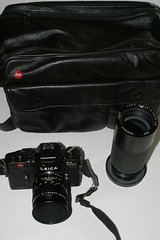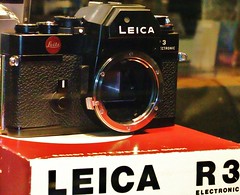Leica R3

|
| R3 image by rst12 (Image rights) |
Leica launched the Leica R3 in 1976. It was the successor of the Leicaflex SL2, and was developed in cooperation with Minolta, together with the Minolta XE bodies. Visually very similar to the Minolta camera it incorporated Leica developed light metering.
At a very difficult time for the company, the R3 was a commercial success ensuring continuation of the R system.
R3 Electronic
Viewfinder
Viewfinder display includes:
- Exposure mode A (automatic) or shutter speed (manual)
- Selected aperture
- Metered shutter speed
Shutter
Copal Leitz CLS electronic metal bladed:
- Manual - whole stops from 4s to 1/1000s, X flash sync 1/90s, B "bulb" (X & B also usable without power)
- Automatic - stepless from 4s to 1/1000s
Metering
Single cell in camera base for selective measurement, light reflected down by a secondary mirror behind the main mirror. Two cells on the pentaprism for integrated "centre weighted" measurement. Electronic selection of either measurement in both exposure modes.
R3 MOT Electronic
Near the end of production a version of the camera was released capable of being fitted with a motor winder made by Eumig.

|
| image by Uwe Kulick (Image rights) |
Links
- Leica R3 on www.collection-appareils.fr by Sylvain Halgand
- R3 catalog on www.collection-appareils.fr by Sylvain Halgand